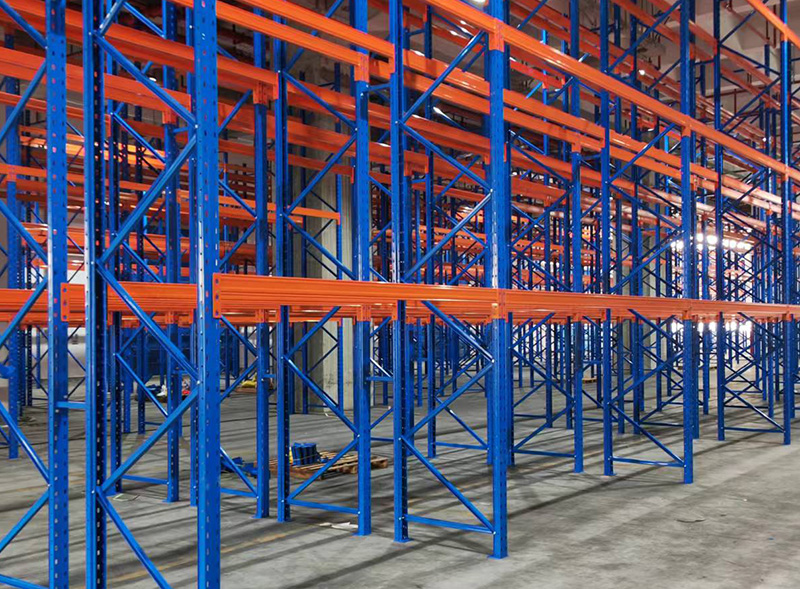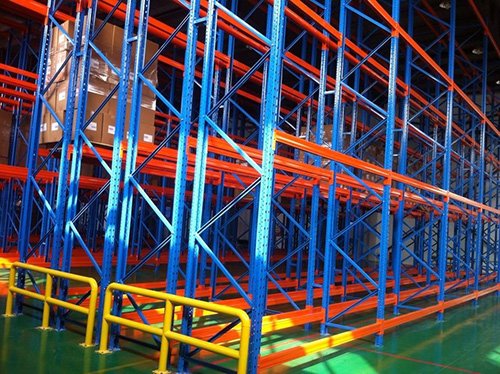In the relentless pursuit of warehouse optimization, space is often the most expensive and constrained resource. Enter Double Pallet Racking – a strategic storage solution designed to dramatically increase pallet storage capacity without expanding your building's footprint. By storing pallets two-deep instead of the traditional single-deep, this system unlocks significant density gains. This comprehensive guide delves deep into double pallet racking, exploring its design, benefits, applications, safety requirements, and implementation considerations, empowering you to decide if it's the key to unlocking your warehouse's full potential.

Understanding the Core Design and Mechanics of Double Pallet Racking
At its heart, double pallet racking (often called double-deep racking) is a variation of selective pallet racking, the most common warehouse storage system. The fundamental difference lies in the arrangement of the upright frames and the use of specialized load beams.
Frame Structure: Unlike single-deep racking where upright frames are placed directly opposite each other across the aisle, double pallet racking features frames spaced further apart. The distance between two consecutive uprights within the same run is increased to accommodate two pallets stored back-to-back.
Beam Configuration: Specially designed, longer load beams span this wider distance between uprights. These robust beams support pallets placed not only on the front row but also on the second row directly behind it.
Storage Principle: Pallets are loaded and unloaded from the front aisle only. The first pallet in a lane is placed directly accessible at the front. The second pallet is then placed directly behind it on the same beam level. This creates a "lane" of two pallets deep for each storage position.
Access Requirements: Accessing the rear pallet necessitates moving the front pallet first. This is a defining operational characteristic of double pallet racking. It utilizes a Last-In-First-Out (LIFO) inventory rotation method.
This seemingly simple modification – storing two pallets deep instead of one – is the core principle driving the significant space savings associated with double pallet racking.
Unlocking Space: The Storage Density Advantage of Double Pallet Racking
The primary driver for adopting double pallet racking is its remarkable ability to increase storage density. Here's how it achieves this:
Reduced Aisle Count: Traditional single-deep racking requires an aisle for every single row of racks to allow forklift access to each pallet position. Double pallet racking eliminates every other aisle because one aisle now serves two rows of racks (the front row of one run and the front row of the adjacent run facing it). Fewer aisles directly translate to more usable space for actual storage.
Increased Pallet Positions per Square Foot: By utilizing the depth more efficiently and removing aisles, double pallet racking can typically increase storage capacity by 40-50% compared to single-deep selective racking within the same warehouse floor area. This is a transformative gain for facilities constrained by space.
Optimized Cube Utilization: While primarily focused on floor space, the system also fully utilizes the vertical cube of the building, just like selective racking. Pallets are stored multiple levels high, maximizing the building's height.
Ideal for High-Volume SKUs: This density boost is particularly advantageous for storing large quantities of fewer SKUs. Warehouses handling products with high turnover rates or bulk storage needs find double pallet racking extremely efficient.

Operational Benefits and Efficiency Gains with Double Pallet Racking
Beyond pure density, double pallet racking offers several operational advantages:
Lower Cost per Pallet Position: While the initial cost per bay might be slightly higher due to heavier beams and potentially deeper footplates, the cost per pallet position is significantly lower than single-deep racking. This is because you're storing many more pallets within the same building shell and foundation investment.
Compatibility with Standard Equipment (with Caveats): Double pallet racking can typically be accessed using standard counterbalanced forklifts, unlike some very narrow aisle (VNA) systems that require specialized equipment. However, accessing the second pallet requires a forklift with a double-deep reach capability. This means the forklift mast and forks must be able to extend far enough to place and retrieve the rear pallet safely without the truck entering the rack structure. Reach trucks are commonly used.
Improved Layout Flow: Fewer aisles can lead to a more streamlined warehouse layout, potentially reducing overall travel distances for forklifts within the storage areas (though pick paths need careful planning).
Enhanced Inventory Control for Bulk Storage: For operations storing large quantities of identical SKUs per lane, double pallet racking simplifies management. Each lane effectively holds one SKU in depth, reducing the complexity of tracking individual pallet locations compared to highly scattered single-deep systems.
Safety and Handling Considerations for Double Pallet Racking Systems
The LIFO access method inherent in double pallet racking introduces specific safety and operational considerations:
LIFO Inventory Management: The rear pallet cannot be accessed until the front pallet is removed. This mandates a Last-In-First-Out flow. It's unsuitable for FIFO (First-In-First-Out) requirements or for lanes storing multiple SKUs mixed together per bay. Careful slotting is crucial – typically dedicating entire lanes to a single SKU.
Forklift Operator Skill: Operating within double pallet racking demands higher skill levels. Operators must precisely place and retrieve pallets from the second position, requiring excellent depth perception and control to avoid damaging racks, pallets, or product. Double-deep reach capability is non-negotiable.
Rack Protection is Paramount: Given the deeper reach and the potential for less visibility when accessing the rear pallet, robust rack protection is essential. This includes:
Heavy-Duty Column Guards: Protecting uprights from impacts.
Pallet Supports: Installed on the rear beams to prevent pallets from being pushed too far back.
Upright Protectors: On the aisle-facing side of rear uprights.
End-of-Aisle Guards: Protecting the ends of runs.
Load Stability: Palletized loads must be stable and properly sized. Damaged or unstable pallets pose a significant risk when placing or retrieving from the deep position. Consistent pallet quality is important.
Clearance Requirements: Adequate vertical clearance between beam levels and horizontal clearance between pallets stored back-to-back is critical for safe forklift operation and load handling. Design must account for forklift mast dimensions when raised.
Implementation and Suitability: Is Double Pallet Racking Right For You?
Successfully implementing double pallet racking requires careful planning and assessment of its suitability for your specific operation:
Ideal Applications:
Warehouses with severe space constraints needing maximum density.
Storage of large quantities of identical SKUs (high cube, fast-moving goods).
Bulk storage areas where FIFO is not required.
Operations already using counterbalanced or reach trucks capable of double-deep access.
Facilities with relatively uniform pallet sizes and weights.
Less Suitable Applications:
Operations requiring strict FIFO inventory rotation.
Warehouses storing a vast number of different SKUs with only one or two pallets each per SKU (poor lane utilization).
Where quick, random access to every single pallet is constantly needed.
Handling products with extremely high value or strict lot control requiring immediate access to any pallet.
If existing forklifts lack sufficient double-deep reach capability.
Critical Planning Steps:
Thorough Space Analysis: Precise measurements of the building (clear height, floor condition, obstructions).
Pallet & Load Audit: Detailed data on pallet dimensions (length, width, height, overhang), weight (per pallet, per unit load), and load stability.
Forklift Specifications: Confirming the double-deep reach capability (maximum extended fork height and depth) of your existing or planned equipment.
Inventory Profiling: Analyzing SKU velocity, quantities per SKU, and rotation requirements (LIFO suitability).
Professional Design & Engineering: Engaging a qualified rack manufacturer or integrator is crucial. They will design the system based on your specific loads, equipment, and seismic requirements, ensuring structural integrity and safety compliance. This includes specifying beam lengths, upright sizes, frame spacing, bracing, and necessary safety accessories.
Aisle Width Calculation: Determining the minimum safe aisle width based on the turning radius of the specific forklifts being used and the depth of the double pallet racking system.
Operator Training: Mandatory specialized training for forklift operators on the safe handling techniques required within a double-deep environment.
Double pallet racking stands as a powerful and proven solution for warehouses seeking to dramatically increase storage density without costly expansion. By intelligently utilizing depth and reducing aisle count, it offers substantial gains in pallet positions per square foot, leading to a lower cost per pallet stored. While its LIFO nature dictates specific inventory management strategies and demands skilled forklift operation with appropriate equipment, the benefits for bulk storage of homogeneous SKUs are undeniable. Careful assessment of your inventory profile, operational workflows, equipment capabilities, and a commitment to professional design and safety are paramount for a successful double pallet racking implementation. When applied correctly, it transforms underutilized space into a highly efficient storage engine, driving significant operational and financial advantages. For space-starved warehouses prioritizing high-density bulk storage, double pallet racking is a solution that demands serious consideration.







